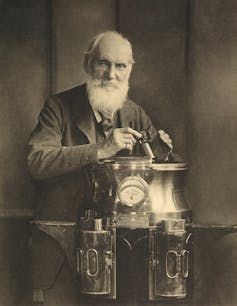“What got you into astrophysics?” It’s a question I’m often asked at outreach events, and I answer by pointing to my early passion for exploring the biggest questions about our universe. Well, along with seeing Star Wars at an impressionable age.
This fascination with the fundamental is a well-trodden path for many budding scientists. Learning about mindboggling fields such as general relativity, which describes the universe on large scales, and quantum physics, which rules the microworld of atoms and particles, can be a powerful way to stimulate young minds.
For many others, however, the road to physics (like hell) is paved with good intentions. What drives their passion is not so much the esoteric secrets of the cosmos, but applying the latest science to solve societal problems and global challenges – from health inequalities to the climate emergency. Both motivations are valid, maybe even essential, helping to form a virtuous circle between “blue sky” research and innovation.
Yet this dual-track approach to research and innovation – core to the contemporary mission of research councils and funding agencies across the globe – isn’t as modern as it may seem. This year marks the bicentenary of the birth of William Thomson, aka Lord Kelvin, arguably the most influential scientist of the 19th century, and perhaps beyond. He was a master at combining fundamental discovery with societal and commercial impact.
Cornerstone of physics
Thomson was professor of natural philosophy at Glasgow University for 53 years, making revolutionary contributions to physics, mathematics and engineering that still resonate today.
He is probably best known for his work on energy and the laws of thermodynamics, the science of heat and work, which are often hailed as the most unbreakable laws of nature. The British astrophysicist Arthur Eddington is reported to have declared in the 1920s that thermodynamics holds “the supreme position among the laws of nature”, adding: “If your theory is found to be against the second law of thermodynamics I can give you no hope; there is nothing for it but to collapse in deepest humiliation.”
Thermodynamics still plays a central role in modern physics, underpinning research in information science, quantum mechanics, cosmology and even theories of life and consciousness. In fact, it is as much a cornerstone of modern physics as general relativity and quantum mechanics. Any final “theory of everything” will need to be consistent with the laws of thermodynamics.
Perhaps Thomson’s most well known discovery is the concept of absolute zero on the temperature scale, which is named Kelvin in honour of the title he would receive in 1892. But when we look beyond his work on thermodynamics, his achievements are remarkable not just for their breadth, but also for their diversity. They range from theoretical breakthroughs addressing the biggest research questions of the day to practical inventions driving industrial and commercial innovation.
Kelvin’s key attributes
What made Thomson so successful? There are three key aspects of his approach to research and discovery that I believe marked him out as a scientist for the ages.

wikipedia, CC BY-SA
First, there was his outstanding mathematical prowess. This allied with his deep appreciation of the power of maths for explaining the natural world – a power upon which he drew heavily throughout his career. This is captured in a profound quote that has been attributed to Thomson: “The fact that mathematics does such a good job of describing the universe is a mystery that we don’t understand, and a debt that we will probably never be able to repay.”
But Thomson was much more than a mathematician par excellence. He also understood that precise measurement and quantification were essential tools for scientific progress – an idea we find expressed in his 1889 book Popular Lectures and Addresses. “When you can measure what you are speaking about and express it in numbers you know something about it,” he wrote.
Thomson’s lifelong talent for inventing ingenious scientific instruments secured him 70 patents, enabled dozens of scientific breakthroughs and made him a highly successful entrepreneur.
Third, there was Thomson’s outstanding ability to think “out of the box”, to look at a problem in a completely novel way. For me, there is no better example of that visionary thinking than Thomson’s work on laying the first transatlantic telegraph cable. This was an immense technological challenge that has been described as the “Apollo project” of the 1800s.
It revolutionised the Victorian world as profoundly as the internet and mobile communications have changed ours.
After failed attempts in the 1850s, Thomson’s genius was instrumental (quite literally!) to the first successful cable-laying expedition in 1865. His understanding of the similarities between heat transfer and electrical transport allowed Thomson to model how electrical impulses would be distorted as they travelled along undersea cables.
But Thomson’s experimental breakthroughs were also key. Instead of using a stronger signal, requiring a much heavier and costlier cable, he invented instruments that could precisely measure extremely weak electrical signals, transmitted as Morse code. They were known as the mirror galvanometer and, later, the syphon recorder. These were essentially a precursor of a modern inkjet printer.
These inventions were game-changers and, as a result, global communications were transformed for ever. As my late colleague David Saxon wrote in 2007, “the transatlantic cable shrank the world more than anything before or since.”
For all of this, Thomson was first knighted in 1866, then later ennobled as Lord Kelvin in 1892 – the first ever scientist so honoured. And Thomson’s elegant combination of ultra-precision technology and cutting-edge theory to detect extremely faint signals resonates strongly with the story of our LIGO laser interferometers, the most sensitive scientific instruments ever built. It was just such a combination that enabled the 2015 Nobel prizewinning discovery of ripples in spacetime known as gravitational waves.
The science and technology of black holes and gravitational waves belong firmly to the post-Kelvin domain of Einsteinian physics. But I believe that domain – and the transformative quantum technology it has enabled – draws inspiration from the pioneering example of William Thomson, who combined fundamental research and innovation to change the world.
#19th #century #scientist #combined #research #innovation #change #world




